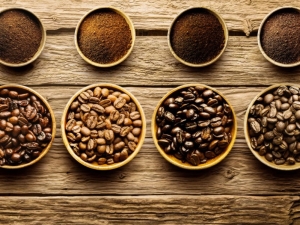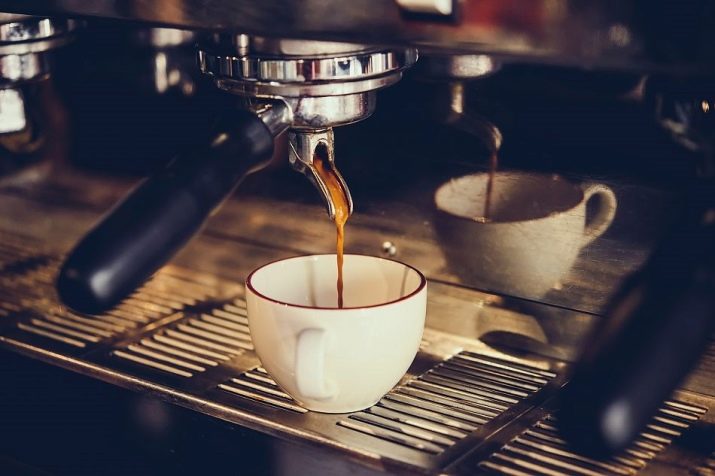Arabica and Robusta: a description and the difference between the types of coffee

On earth there are a very large number of types of coffee tree. For commercial purposes, only a small part of them is used. Only a specialist can understand them. Despite this, many people use this drink every day.More than 97% of all products that are produced for commercial purposes are obtained from only two varieties of coffee tree - Arabica (Coffee Arabica) and Robusta (Coffee Canephora). These trees of the Madder family have similar qualities. But at the same time the differences between them are also enough.
Special features
Consumption in the world of robusta - 30%, and Arabica - 70%. Among these coffee trees there are also different types created by breeding.
A mixture of Arabica and Robusta kernels in various proportions is found on the market.
Arabica is divided into several varieties:
- "Katura";
- "Bourbon";
- "Aramos";
- "Tipika".
The names of hybrid varieties that are obtained by crossing Arabica and Robusta:
- Pacamar;
- Timor;
- "Katatui."
The main differences between Arabica and Robusta are the chemical composition and cultivation techniques that influence the taste of grain and drink from it.
Arabica can grow at an altitude of 750-850 meters above sea level and needs careful maintenance. Robusta grows only on the plains and does not require special attention.
If you look well, then the type of grains is different, especially after roasting. Arabica is an oval grain, after heat treatment has a uniform surface color. It is smaller in size than Robusta, which is a round grain. It is difficult for him to give even color when roasting.
The advantages of Arabica are that its taste is much brighter and richer - this makes it a favorite drink among the majority of the population of the planet. Robusta also has its dignity - it has more caffeine.
Where do they grow?
Arabica was discovered in the 9th century in Ethiopia, but it is often called “Arabian coffee”. There is a legend that the Arabs, having learned and tried this drink, decided to plant a plantation on their own land. They brought coffee trees to the Arabian Peninsula, where Arabica caught on without much effort.
The height of arabica tree can reach five meters. One coffee tree gives about 5 kilograms of crop. 15-25 degrees of heat is the ideal temperature for optimal development and growth. The fruits ripen in 7-9 months.
Robusta was later discovered by Arabica for the whole nine centuries in the Congo, therefore this coffee is also called Congolese.
Robusta in translation means "strong." So called this sort of coffee tree due to the fact that it can grow in those conditions in which arabica can not exist.
Robusta coffee trees became popular in the 20th century due to the death of arabica from leaf rust. After that, Robusta was transported to the island of Java and other tropical countries. It is currently growing more in Colombia, Africa and Asia.
The height of the Robusta tree reaches 10 meters. With one tree you can get 1.5 kilograms of the crop. The fruits ripen in about 10 months.
Chemical composition
Experts believe that the quality of Robusta is much higher than that of Arabica, although the latter is much more expensive. If there were no mixtures of varieties, many could not simply afford to buy 100% Arabica.
The amount of caffeine in the composition of the beans varies depending on the type of coffee. Arabica beans contain little caffeine - its ratio is only 1.2%. Robusta also contains 3.2% caffeine in its composition.
In Arabica, there is more sucrose, and in Robusta, there is chlorogenic acid.
Coffee has a high protein content. Again, Arabica has surpassed the Robusta variety, it contains 3% more proteins.
Arabica has a high content of nutrients. The variety is rich in vitamins PP, E and B. And it also contains calcium, iron, potassium, sodium and phosphorus. Arabica is used not only as a flavored and invigorating drink, but also as a pharmacological agent. It contains alkaloids, which are used to make various preparations for migraine, overwork or panic attacks, nervous breakdowns or psychosis.
These types of coffee also differ in the content of aromatic oils in their composition. Arabica contains 18% of essential oils, while Robusta contains slightly less than 9%.
Arabian coffee has a huge range of flavors and flavors. After dry or semi-dry processing, coffee has the smell of fruit or blueberries, and after roasting, the beans emit sugary tones. The aroma of grain Arabica is felt even through closed packaging.
Taste qualities
Robusta has a peanut or rubber smell before roasting due to its high caffeine content. This component is both a positive and negative trait of this variety. Robuste is two times less fructose, unlike Arabica, which makes this variety sour.
You can experiment with Arabica by adding various spices and ingredients. Robusta is not suitable for such purposes. There are many recipes for making a coffee drink, but in almost all cases arabica is used.
Almost always a mix of arabica and robusta is used on the shelves, which makes coffee packaging cheaper. This coffee has a longer shelf life, because the taste in Robusta lasts longer than in Arabica. The roasting of these mixtures is dark. It is necessary in order to eliminate the bitterness of robusta and emphasize the taste of Arabica. The manufacturer must specify the composition only when the mixture is more than 5% Robusta. In other cases, it is permissible to indicate “100% Arabica” on the package.
What is the difference?
An increased amount of caffeine and chlorogenic acid makes Robusta bitter, which it will not be if well and properly roasted. Because of lipids, Arabica has a pleasant, tart flavor, and sucrose adds, besides sweetness, also a special sourness that can never be found in another variety. Robusta is just an invigorating strong drink with a high content of caffeine. There are no fruit and berry notes in its aroma, because of this, not everyone likes it. You can compare Robusta with a very poor-quality and old Arabica, but not with fresh coffee.
Arabica grows at an altitude not lower than 600 meters above sea level, whereas Robusta can grow on the plains. Robusta needs a fairly warm and humid climate - from 18 to 36 degrees, and precipitation is not less than 2200 mm. Arabica can grow in a cool and less moisture-rich climate - at temperatures ranging from 15 to 24 degrees and with precipitation not exceeding 2,200 mm per year. That is the difference of their tastes.
To distinguish Arabica grains from Robusta grains is not difficult at all. Arabica grain has an oval-elongated shape, a wave-like incision with remnants of the peel. Its color is from green to gray. Length - from 5 to 8 millimeters. Robusta, on the contrary, is rounder, its cut is even and short, it has a sandy gray color.
Arabica can reach a height of 5 m, Robusta - 8-10 m.
Arabica is self-pollinated, as it has everything you need for self-pollination. Pollen fertilizing flowers, must be from the same tree. If it is not pollen that is taking root, but other trees, then varieties are crossed. Because of this, it is forbidden by law to grow robusta in Costa Rica.
Robusta is the other way around - there must be another tree nearby, otherwise it will not be able to pollinate. Not only the same varieties can interbreed, but other species as well. For example, when Robusta pollen was blown by Arabica plants on Timor by wind or animal fertilization, the Timor variety appeared.
Arabica consists of substances that cause more love for coffee than addiction. These include lipids - 15-17%, sugar - 6-9%, caffeine, which is less than in Robusta - 1.2-1.5%, and chlorogenic acid - 5.5-8%.
Robusta also contains less sugars - 3-7%, two times less lipids - 10-11.5%, but 2.2-2.7% caffeine and 7-10% chlorogenic acid.
Lipids are complex, simple and fat-like. For the assimilation of vitamins of groups A, D, E, K (liposoluble), lipids are needed. This component has the function of storing, thermoregulatory, and is also a source of metabolic water. When roasting, they do not break down like caffeine due to their heat resistance.
During frying, the sugar in coffee breaks down into H2O (water), CO2 (carbon dioxide), and small organic acids, giving it a dark color and characteristic aroma. Fruit and berry sour notes give arabica variety uniqueness and originality.
Arabica, unlike Robusta, will cost more because of its quality and painstaking care when growing fruits. In the market, the price of Arabica is twice the price of Robusta.
In terms of care, Robusta variety is no longer whimsical. Due to the high content of caffeine and chlorogenic acid, it is immune to various diseases and parasites. Arabica requires very careful care - you always need to ensure that coffee diseases or parasites do not destroy the entire plantation, and the variety also requires regular preventive measures.
Recommendations
As you know, the most famous and popular variety is Arabica. But there are countries that highly respect and robust for its strength, bitterness and long history. Those people who appreciate coffee for its magical taste and aroma, of course, choose Arabica. But for those who drink this drink in the morning for cheerfulness or at night during the preparation for the exams, Robusta will do. But do not overdo it with this drink, because it increases blood pressure. If a person has a working low pressure, then after drinking a cup of coffee, it rises and becomes ideal for sleeping. For people with high blood pressure, this drink is not recommended.
There are many recipes for making coffee or coffee drinks - from espresso to Irish coffee. The taste of the finished drink depends not only on the choice of variety, but also on the correct preparation.
Espresso is served in small cups of 30-35 ml. He is considered the strongest of all coffee soft drinks. But when brewing such a coffee, it loses a lot of caffeine, which is why it does not “beat” so much on the circulatory system.
There are also different recipes for making a drink with the addition of alcohol. These include Irish coffee. The main component of the cocktail - Irish whiskey. Coffee, cane sugar and cream are added to it. This is usually two servings of espresso, 30 ml of whiskey, one teaspoon of sugar and two tablespoons of whipped cream.
All ingredients are mixed in a specific sequence, except for the cream, which is whipped and decorates the finished drink in the form of fluffy foam.
On the differences between Aribicus and Robusta, see the following video.

































